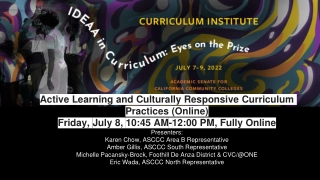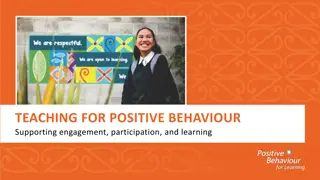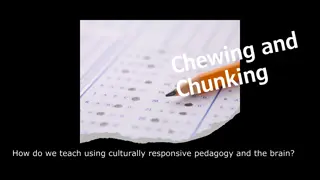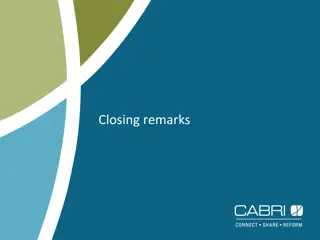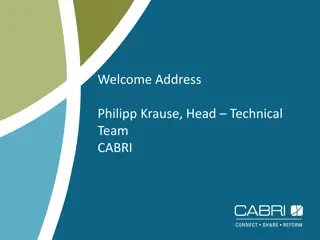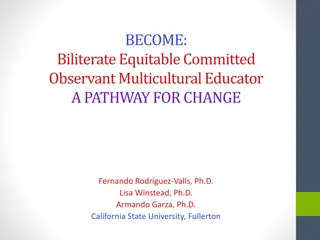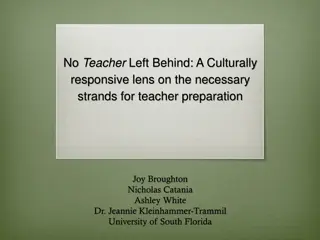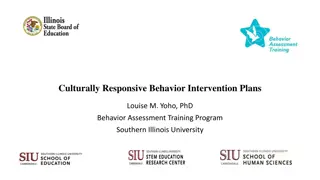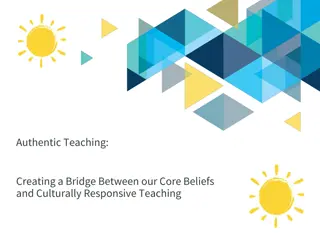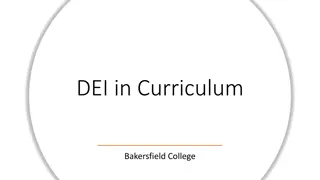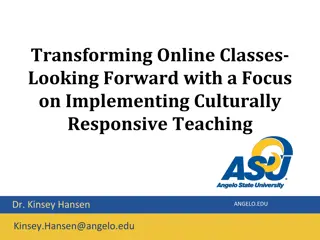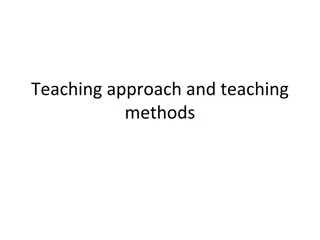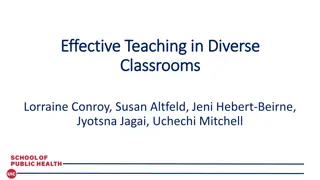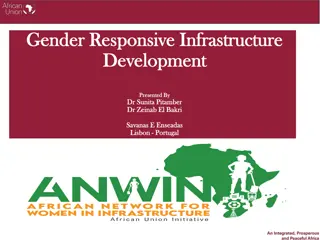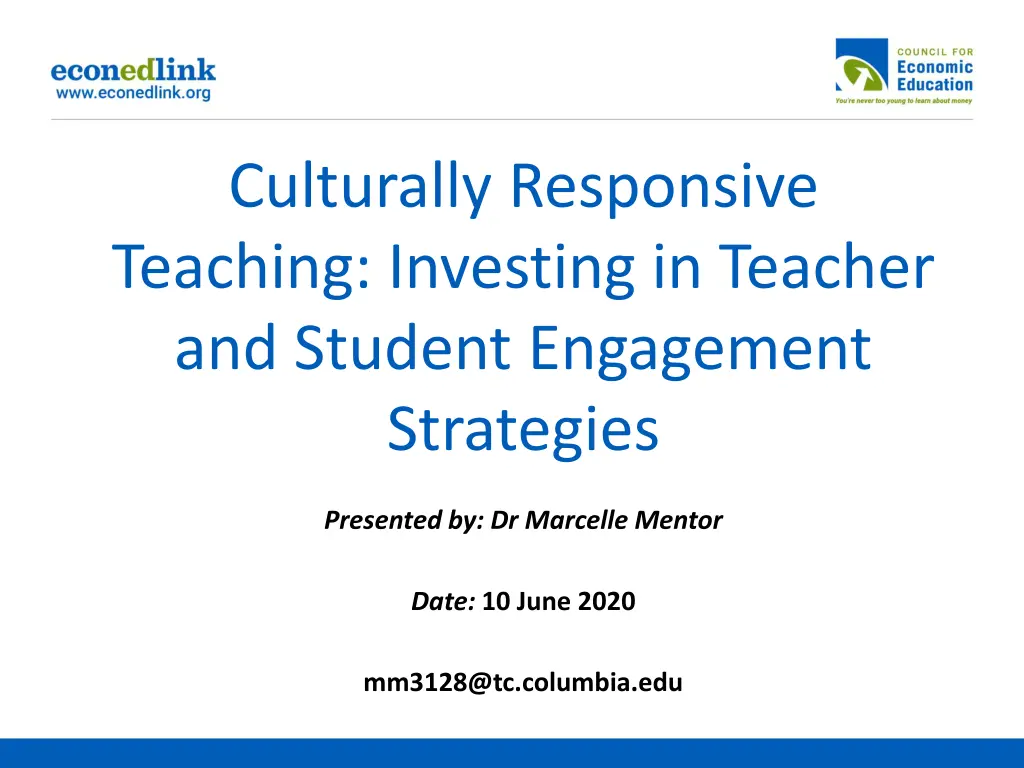
Investing in Culturally Responsive Teaching Strategies
Explore strategies to enhance teacher and student engagement through culturally responsive teaching, including starting difficult conversations, promoting anti-racism, supporting students, and more.
Download Presentation

Please find below an Image/Link to download the presentation.
The content on the website is provided AS IS for your information and personal use only. It may not be sold, licensed, or shared on other websites without obtaining consent from the author. If you encounter any issues during the download, it is possible that the publisher has removed the file from their server.
You are allowed to download the files provided on this website for personal or commercial use, subject to the condition that they are used lawfully. All files are the property of their respective owners.
The content on the website is provided AS IS for your information and personal use only. It may not be sold, licensed, or shared on other websites without obtaining consent from the author.
E N D
Presentation Transcript
Culturally Responsive Teaching: Investing in Teacher and Student Engagement Strategies Presented by: Dr Marcelle Mentor Date: 10 June 2020 mm3128@tc.columbia.edu
Education: Ph.D. Teachers College, Columbia University M.Phil. Columbia University Ed.M. Teachers College, Columbia University M.Phil (ethics) Stellenbosch University, South Africa B.A. English Lit., University of the Western Cape, South Africa Experience: H.S. English Teacher English Instructor, Adult Learners City College, TFA @ PACE, Teacher Educator and Professional Development, Teachers College Lecturer and Program Coordinator English Education at Teachers College.
Share strategies to invest in personal/professional growth while maximizing student engagement through a culturally responsive lens.
Objectives Teachers will be able to Teachers will be able to: Learn how to start difficult conversations with their students. Learn how to sustain and build upon the dialogue into works of anti-racism and full inclusion materials in our classrooms and schools. Use tools and resources to support students.
Agenda Defining terms Navigating Culturally Relevant and Responsive Pedagogy Pausing for some thoughts, comments and questions Culturally Sustaining Pedagogy Some Best Practices Next Steps
Culturally Relevant Teaching (Ladson-Billings) Culturally Responsive Teaching (Gay) Culturally Sustaining Teaching (Alim and Paris)
Culturally Relevant Teaching or responsive teaching is a pedagogy grounded in teachers displaying cultural competence: skill at teaching in a cross-cultural or multicultural setting. Teachers using this method encourage each student to relate course content to his or her cultural context.
Culture is central to learning. It plays a role not only in communicating and receiving information, but also in shaping the thinking process of groups and individuals. A pedagogy that acknowledges, responds to, and celebrates fundamental cultures offers full, equitable access to education for students from all cultures. Culturally Responsive Teaching is a pedagogy that recognizes the importance of including students' cultural references in all aspects of learning (Ladson- Billings,1994).
In her 2000 book Culturally Responsive Teaching, Geneva Gay, defined CRT as teaching that is: Validating the values, prior experiences and cultural knowledge of students Comprehensive Transformative Emancipatory
Builds on what we already know. There is more than one way of knowing. Encourages us to embrace our own culture and develop a love of learning and so what does that mean when we are looking to hire purposefully to grow our students access to different cultures Highlights strengths, and gives us confidence to confront their weaknesses.
In our multicultural society, culturally responsive teaching reflects democracy at its highest level. It means doing whatever it takes to ensure that every child (student) is achieving and ever moving toward realizing their potential. --Joyce Taylor-Gibson
Halfway mark questions Halfway mark questions Are you practicing any form of Culturally Responsive Pedagogy? Could you do more? What would I need to know to do more ? Jot down questions, thoughts or ideas you may have at this point.
Culturally Sustaining Pedagogy seeks to perpetuate and foster to SUSTAIN linguistic, literate and cultural pluralism as part of schooling for positive social transformation. CSP exists wherever education sustains the lifeways of communities who have been and continue to be damaged and erased through schooling.
Culturally Sustaining Pedagogy, contd Nobel Laureate, Morrison, 1998 talks about the panoptic White Gaze that permeates educational research and practice with and for students of color, their teachers and their schools. She goes on to say: As though our lives have no meaning and no depth without the White Gaze In response to this Alim and Paris ask: What would our pedagogies look like if this gaze weren t the dominant one?
Dialogues on race/ethnicity and culture Caring (Noddings, 1986; Valenzuela, 1999) Analyzing school climate who feels comfortable and safe? Who feels uncomfortable and unsafe? Continuously analyzing student achievement data Professional Development on learning styles
Schooling process operates on cultural nuances (e.g., agriculture calendar, giving teacher an apple, speaking up in class, calling teacher by last name). Culture of others has historically not been acknowledged in the schooling process and resulted in differential outcomes (Banks, 1987, 2001; Delpit, 1993; Sleeter, 1987).
Be honest about where you are as an individual, and a school Get to know the research Let the research inform your decision-making process Implement realistic (time-bound, measurable goals) Follow-up and follow through with professional development and periodic assessment
The increasing diversity in our schools, the ongoing demographic changes across the nation and the movement toward globalization dictate that we develop a more in-depth understanding of culture if we want to bring about true understanding among diverse populations. Maria Wilson Portunando
Oppression - the state of being subject to unjust treatment or control. Race Stuart Hall (Cultural Theorist) states that race is a floating signifier. Class - a group of people within a society who possess the same socioeconomic status. Privilege - a special, unearned advantage or entitlement, used to one's own benefit or to the detriment of others What are assumptions we make? What is our positionality both personally, and as a school? How do our students know that?
Be honest about what you know or dont know Be vulnerable and open Let the kids lead Listen Check your privilege (as the the authority) Do some self excavation (Ruiz, 20 ) Walk alongside your students
What can you do What can you do? Take the anti-bias assessment. Learn more about Culturally Relevant, Responsive and Sustaining Pedagogy, and how you can adapt and change to enrich your curriculum, pedagogy and school culture. Get to really know your students, how they fit into the school culture and how the school fits into the communities they serve (even when students are bussed in).
Have your thoughts or understandings been influenced by this session? What challenged you? What do you want to work on? What do you personally want to implement? What do you want to see implemented as an institute? Use the Protocol: What, So What, So What, Now What, Now What? What?
Assessment Questions 1. What would it look like at your schools to create a culturally relevant AND responsive learning environment? 2. What would some obstacles be? 3. What could potentially be challenges in sustaining it? 4. What would benefits of creating and sustaining it? 5. What are lingering questions do you have? What do you think are next steps for you?
Alim and Paris (2017) Culturally Sustaining Pedagogies: Teaching and Learning for Justice in a Changing World. New York: Teachers College Press Banks, J. A. (1987, 2001) Educating Citizens in a Multicultural Society. New York: Teachers College Press. Delpit, L. (1993). The Silenced Dialogue: Power and Pedagogy in Educating Other People's Children" in Beyond Silenced Voices: Class, Race, and Gender in United States Schools (L.Weis, M.Fine, eds). Gay, G. (2000). Culturally Responsive Teaching : Theory, Research, and Practice (Multicultural Education Series, No. 8). New York: Teachers College Press.
Grant, C. A., & Sleeter, C. E. (1987). Who determines teacher work? The debate continues. Teaching & Teacher Education, 3(1), 61-64. Ladson-Billings, G. (1995). The Dreamkeepers : Successful Teachers of African American Children. San Francisco: Jossey Bass. Noddings, N. (1986). Caring - a Feminine Approach to Ethics and Moral Education. USA: University of California Press. Valenzuela, A. (1999). Subtractive Schooling: U.S.-Mexican youth and the politics of caring. Albany, NY: State University of New York Press.
Questions and Talk Back Dr. Marcelle Mentor mm3128@tc.columbia.edu
Academic Articles What, So What, Now What protocol Cultural Knapsack
CEE Affiliates https://www.councilforeconed.org/resources/local-affiliates/

